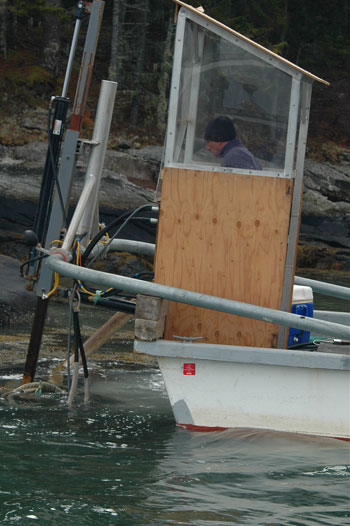Mechanical Seaweed Harvest Disputed
by Steve Cartwright

Mechanical harvest of seaweed being demonstrated in Bremen, Maine. Proponents argue the machine leaves enough of the plant in place for regeneration. Opponents argue the recovery time is too long and species dependent on the plants are impacted. Hand harvesting is another method. Rights in the intertidal zone have long been debated and still are in Augusta.
On a boat tour meant to convince onlookers of its benefits, a small barge motors alongshore amid rocks and rockweed, its operator skillfully manipulating a mechanical arm that reaches down with whirling blades to slice beds of seaweed.
A vacuum system sucks the cut weed into a net bag, and these plants will be turned into animal, plant and human food, commercially.
It’s farming the sea, and Doug Wood of Waldoboro, who organized the demonstration on Muscongus Bay, has acquired two vessels for this purpose. Observers included two reporters, two legislators, and the owners of Atlantic Labs, and Ocean Organics, both Waldoboro-based producers of seaweed fertilizer and feeds. Rep. Ellen Winchenbach, a Waldoboro Republican, has sponsored an industry-supported bill that would repeal existing rules and create a statewide plan to manage harvesting.
That’s not a good idea, says Dr. Robin Hadlock Seeley, who is affiliated with Cornell University the Shoals Marine Laboratory on Appledore Island. “Machine harvesting is extremely dangerous. If an operator is a little over-zealous, a lot of damage can happen in a short time. Plant mortality is much higher with mechanical harvesting,” she said.
Harvesting can be done by hand, and it’s much less damaging, Seeley said. With mechanical cutting, more than 30 percent of seaweed plants die. Maine seaweed harvesting on a commercial scale began about 40 years ago.
Wood told onlookers at the demonstration that “it is absolutely impossible to over-harvest” with the Norwegian pump design aboard his vessel. He said because of the design and the rough terrain where plants grow, “we aren’t even giving them a haircut.” He dismissed Seeley’s assertions as “bull.”
Seeley believes the intertidal zone is too sensitive and too important to sustaining marine life for its seaweed forests to be chopped down.
Proponents of harvesting say it grows back. Opponents say not fast enough. Seeley said while kelp can grow 1 centimeter per day, rockweed only grows 3-16 centimeters per year. So it takes years for seaweed to become sizeable, and in the meantime, clear-cut areas are no longer home to periwinkles and other marine life. Some “holdfasts,” the part of the seaweed that attaches itself to rock, can be 400 years old, Seeley said.
Doug Wood claimed the demonstration that there is no bycatch. Seeley claims there is a lot of bycatch, especially “wrinkles,” or periwinkles, that some people gather to sell on a small scale.
Seaweed plays a role in sustaining 150 other marine species, she said. If areas are stripped bare of rockweed, other species such as green slime can take over. It might take up to 18 years for cutover areas to recover, she said.
Seeley has for several years worked with Cobscook Bay property owners who don’t want their seaweed cut, and the Legislature in 2009 approved the Cobscook Bay Rockweed Management Area, protecting about half of the shoreline from any seaweed harvesting. Winchenbach’s bill would nullify that protection, which some say came about because of a Canadian company’s “heavy handed” harvesting approach in the bay.
“We need that bill and we don’t need any amendments,” said Bob Morse, head of Atlantic Labs in Waldoboro, referring to Winchenbach’s proposed legislation.
Seeley claims the Department of Marine Resources is already financially stressed and would not be able to enforce any new management plan. Further, she said, nobody knows what level of harvest is sustainable, and nobody knows the “cumulative effect” of long-term rockweed harvesting. “The ecological sustainability is completely unknown,” she said.
Complicating matters is an ongoing dispute over who owns the intertidal zone. Is it the landowner or the state? Legal references go back to a 1740 Massachusetts law on the intertidal zone. The Maine legislature has not made a definitive statement on that law.
This issue remains unresolved, as several thousand tons of seaweed is taken from Maine’s shoreline every year.
Seaweed is then dried and packaged and shipped around the country. Historically, coastal dwellers mulched gardens with rockweed, and Native Americans knew about the benefits of seaweed long before the European colonization.
